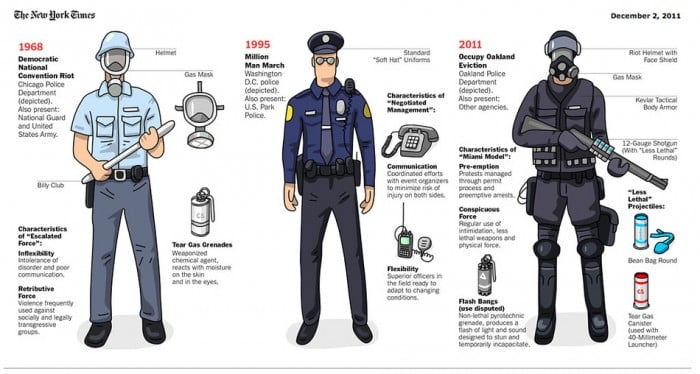When I was growing up, the echoes of the 60’s and early 70’s protests along with the brutal police response lingered heavily along with the post-Vietnam era … and as more civil protests and cooperative ways to try to change things, so too did the police response – and the outfits they wore.
I was flipping through an old copy of a local paper that covered the school walkout in 1981 at the announcement of the impact of the Proposition 2.5 cutbacks on the school. The headline said 200 walked out and there were 5 arrests. The images showed a bunch of kids, and the police looking like … police. No kevlar, no automatic weapons, nothing special or ultra-militaristic. They didn’t get into lines and barricade things, nor did they start pepper-spraying or tossing tear gas. It was a very low-key event by today’s standards.
Which makes the image and accompanying text from the New York Times even more striking:
Just as the styles of protest have changed from one generation to the next, so have the styles of protest policing. Technological advances, training innovations and changing attitudes toward the right to assemble have all shaped the way the police handle the challenges of large demonstrations. During the 1960s and ’70s, police officers treated many protests as a threat to the social order and responded with brute force. In the 1980s and ’90s, demonstrations tended to be less confrontational and the police responded with more accommodating tactics.
Following the “Battle in Seattle” protests against the World Trade Organization in 1999, a more restrictive, preemptive and aggressive form of protest policing emerged at the 2003 protests in Miami over the Free Trade Area of the Americas. The current Occupy demonstrations have adopted a defiant and disruptive style of protest that has pushed the boundaries of the First Amendment, but the response has been mixed. While many cities have evicted encampments and blocked marches through enormous shows of force, others have tried to use communication and flexibility to preserve the nonviolent if disruptive character of these protests.
I had said before that we have returned – and passed in many ways – the ‘never going back to THAT’ days of the late 60’s. I am not claiming it is all the fault of the police or other authorities – especially when for some people the way to celebrate a sports team doing well is to loot stores, tip cars, and destroy the city. What I am saying is that it is a shame that it feels like in every way over the past decade our immediate response is one of extreme violence.
What do you think?
